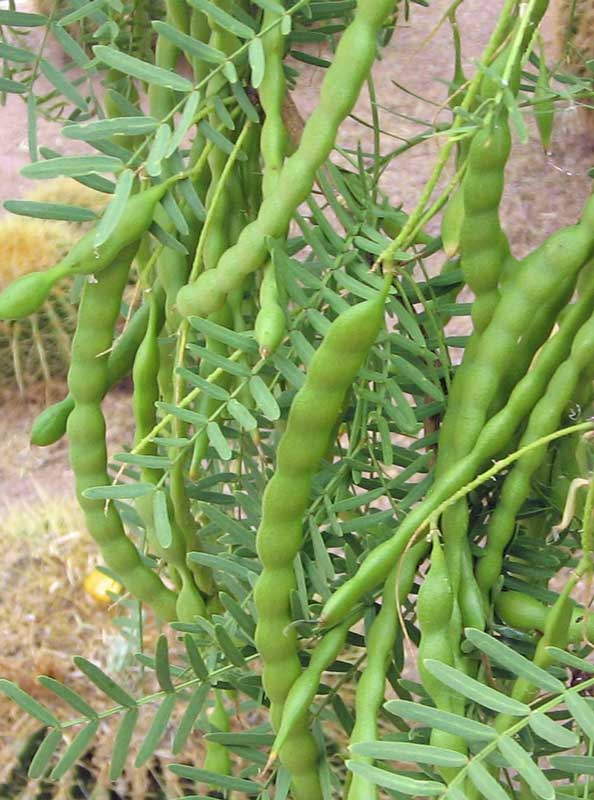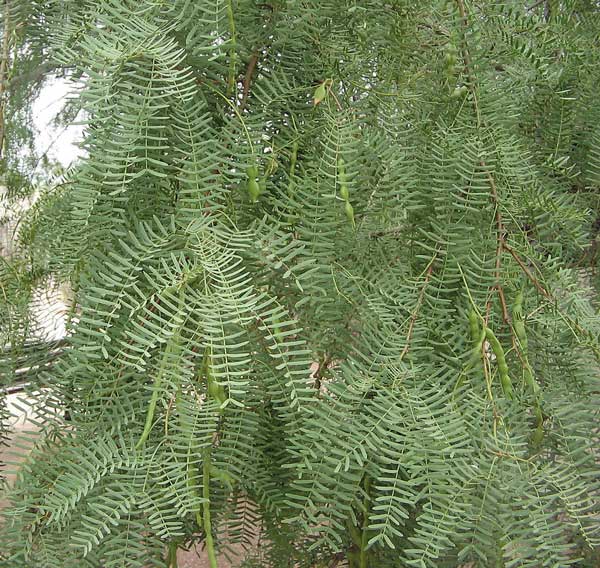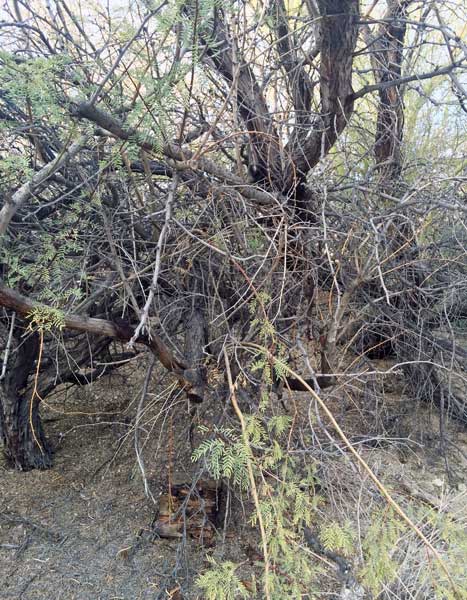Ethnobotany of southern California native plants:
Western Honey Mesquite (Prosopis glandulosa)

By Don A.W. Carlson GFDL, CC-BY-SA-3.0
Mesquite bean pods.

By Don A.W. Carlson GFDL (GNU), CC-BY-SA-3.0
Dense mesquite foliage and pods
Western Honey Mesquite (Prosopis glandulosa)
The mesquite tree was one of the most important food sources for Native Americans in southern California. A flour can be milled from the mesquite bean pods that is high in both carbohydrates and protein.
The mesquite tree is a low hanging tree that can grow up to 20-25 feet high. The honey mesquite, Prosopis glandulosa, is a thorny medium sized tree. As featured in the photos, mesquite plants display thick foliage of bright green, deciduous compound leaves.
Large, yellow pods appear on the tree in early summer. These pods contain multiple beans. In June and July, as the pods become ripe, the beans take on a straw colored appearance. In late summer, the fleshy pods begin to dry out and becomes brittle.
Honey mesquite food
Mesquite beans were often eaten raw. However, more commonly, the brittle pods were collected and ground on a stone metate and mortar. A flour was produced that could be combined with hot water to produce an atole. Atole is a porridge type meal, resembling gruel. The taste is described as having a rich, caramel, and nutty flavor. Animal fat was added to mesquite flour to thicken up the flavor. Allowing the gruel to sit and ferment helped add flavor.
The Tohono O’odham and Pima people of northern Mexico and southwestern Arizona relied heavily on mesquite pods for food. These pods are 40% protein and enriched with minerals: zinc, iron and calcium.
The high soluble fiber content is an additional benefit to mesquite flour. Soluble fibers are thought to prevent health problems associated with high cholesterol and diabetes. The reliance of Native Americans on mesquite powder is surely part of the reason for their vigorous health in the hot desert. In general, as Native Americans became assimilated into western society, the health of these people suffered. Diabetes, for example, became more common within this demographic in modern times. It is speculated, that the shift in eating mesquite pods to more refined sources of carbohydrates may be partially to blame for this shift in health.
Aside from a food source, the honey mesquite has other features that made this plant very useful to early settlers. The tree grows extremely rapidly, even in drought years. In doing so, mesquite produces dense shade from the intense midday sun.
The wood from its branches are thick and were considered one of the best sources of firewood. In fact, today mesquite charcoal remains one of the best fuels for backyard BBQs.
The large limbs were useful in the construction of shelters.
Long, slender branches could be turned into bows or weapons.
Flowers from the honey mesquite were roasted and squeezed into balls. These could then be popped in the mouth as a snack.

Honey Mesquite in the winter.
Please return to our main Ethnobotany of southern California page.
On our main ethnobotany page, we present a clickable list of the southern California native plants that became a part of the culture of Native Americans and early European settlers. These plants were used for medicine, food, shelter, drink, tools and art.
Warning: The information about plants on this website is intended for general educational purposes only. The author of this website accepts no responsibility for problems arising from the user’s misidentification, misuse, or use of plants. Please read the full TERMS associated with this website.
